
RULES OF THE ROAD
Okay, so you’re taking your own car into France and driving through to whatever destination for the very first time. You drove in Spain for a week about ten/fifteen years ago, but that was a hire car. Firstly: Don’t worry. Just be cautious; driving in Europe isn’t all that different from driving at home; it’s just it may feel a little strange at first, having your steering wheel on ‘the wrong side’, especially coming up to junctions and turning into roads. Once you have your mirrors sorted out and your blind spots covered, drive defensively; observe, think for those driving around you, fit in and avoid big-city driving when you can: And wear your seat belt…
I drove 10,000+ miles last year, from my home to Sicily and back. Below are my tips for driving safely and enjoyably on European roads. (For a complete A-to-Z index of European-country driving tips, see the AA’s website and other links below this article.)
Overtake like an European.
When overtaking other drivers do it boldly but carefully. On winding, narrow roads a slower car may use hand-signals to indicate that it is alright for you to pass. (These signals are used inconsistently — and shouldn’t be blindly relied on.) As in your own country, it is still your responsibility to make sure it is safe to take an action like overtaking.
Understand the lane markings — in France a single, solid, white line in the middle of the road means no passing in either direction; in Germany it’s a double white line.
You’ll soon learn that on the autobahn (or Toll Road) you must not stay in the passing lane once you’ve overtaken. Although you’ll see it being done, do not overtake a vehicle on it’s inside. (On the continent that is the right.) The only exception is when you are in traffic lanes that are being directed to various destinations.
Learn to check which way you LOOK. Until you drive abroad you will not realise how ingrained it has become to look in a certain direction to check the traffic as you approach a junction. When approaching roundabouts particular caution needs to be taken, as you will automatically look to your right if you are British, when you need to check to your left. Traffic on roundabouts always has the right-of-way, while entering vehicles yield, the same as in Britain, except where road markings dictate.
The Roundabout.
Especially in heav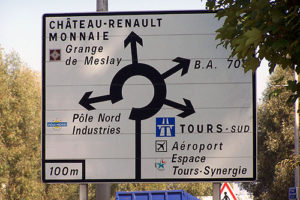 y traffic this may become a high-pressured point that requires a snap decision about where and which exit to take. Take the stress out by making it a standard practice to take a 360-degree tour round it to explore your options. This will also give your navigator time to work out where you are going, where the exit is, and help guide you on the second time around. (And don’t feel foolish; no one will know you’ve gone round twice – and if they do, who cares? They’ll put it down to those crazy Brits. Just make sure you check your mirrors and use your indicator before you switch lanes.) Remember; if you have a navigator they are your second set of eyes. Make use of them; they are invaluable. Another person to look out for you.
y traffic this may become a high-pressured point that requires a snap decision about where and which exit to take. Take the stress out by making it a standard practice to take a 360-degree tour round it to explore your options. This will also give your navigator time to work out where you are going, where the exit is, and help guide you on the second time around. (And don’t feel foolish; no one will know you’ve gone round twice – and if they do, who cares? They’ll put it down to those crazy Brits. Just make sure you check your mirrors and use your indicator before you switch lanes.) Remember; if you have a navigator they are your second set of eyes. Make use of them; they are invaluable. Another person to look out for you.
As you approach complicated junctions you’ll invariably pass a diagram showing the layout with the various exits. In most cases the roadway is painted with the road name or town to which the lane leads.
Sat Navs.
(GPS)  I realise that some people don’t like them; Jackie is included in those who would rather put their trust in road signs and maps. Yes; if not all the information is entered correctly, or some is left out (like new roads, for instance) then the voice in the box (a female on mine – I call her Miss Satnav) will direct you wrongly. But on a motorway, to pick the right lane, or when wanting to get out of a town quickly when you are lost they are a boon, and they will find your obscure B&B. (This paragraph is already a sore point of contention!!!) But I love her (Miss Satnav, that is) and would be bereft without her. (N.B. Do keep it up dated, as it is surprising how quickly things change when a new section of road is opened or upgraded.)
I realise that some people don’t like them; Jackie is included in those who would rather put their trust in road signs and maps. Yes; if not all the information is entered correctly, or some is left out (like new roads, for instance) then the voice in the box (a female on mine – I call her Miss Satnav) will direct you wrongly. But on a motorway, to pick the right lane, or when wanting to get out of a town quickly when you are lost they are a boon, and they will find your obscure B&B. (This paragraph is already a sore point of contention!!!) But I love her (Miss Satnav, that is) and would be bereft without her. (N.B. Do keep it up dated, as it is surprising how quickly things change when a new section of road is opened or upgraded.)
Know the laws:
- Lights: Many European countries require you to have your running lights on any time the car is running – even in broad daylight. (Most newer models of European cars have this on as an automatic function, but if yours don’t, make sure your sidelights are on before you drive.)
- Phones: Like Britain all European countries forbid talking on a cell phone without a hands-free headset.
- No right on red: (This one is for our American cousins) It’s illegal to turn right on a red light, unless a sign or signal specifically authorizes it (most common in Germany).
- Children: Like Britain, European countries require safety seats for children of three years and under, although booster seats for older ones seem to be optional. In nearly all European countries children under 12 aren’t allowed to ride in the front seat without a booster seat; some countries ban children from the front seat altogether, while others have rules that restrict teens up to 18 from the front seat. (It is wise to check with the specific countries you are visiting.)
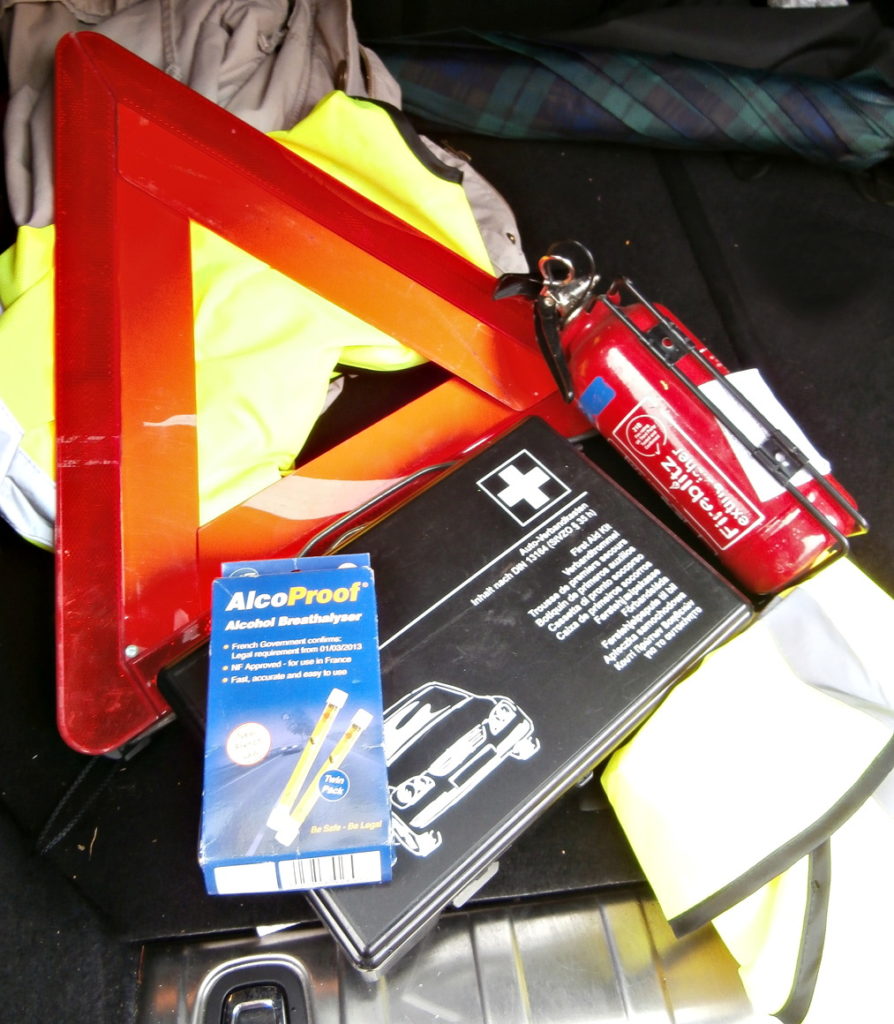
- Safety kit: Many countries require each car to carry a reflective safety vest, a kit with a reflecting triangle (typically supplied by the rental company). A fire extinguisher and a set of bulbs and fuses; you’ll also need headlight beam-deflectors to stick on your headlights and a GB sticker for the rear if you don’t have one on your number plate, and a first-aid kit.
- Breathalysers: The enforcement of the law making it compulsory to carry breathalysers whilst driving in France has been postponed indefinitely. Whilst the law itself is still in place, the authorities have recognised problems with the supply of suitable breathalysers and will not issue fines until further notice. We recommend that you still carry breathalysers, and we will inform all our subscribers as soon as we know of a date for the re-introduction of the fines. (Link below to purchase them)
- Low-emissions zones: In many cities, cars must meet a certain emission standard in order to enter. You need to do your own checks in advance.
Don’t drink and drive.
Should I say more? You need all your wits about you – and there’ll be plenty of time to relax and quaff some wine at the end of the day.
Learn the signs: 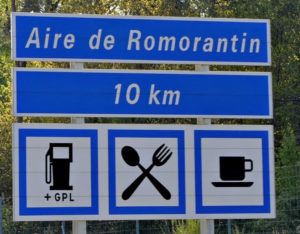 Because we Brits have been in the European Union a long time we use the same simple set of road symbols; it takes just a few minutes to learn them (this applies to our American cousin across the pond). Many major rest stops have free local driving almanacs (or cheap maps) that explain such signs, roadside facilities, and exits. The Aire in France is one such facility that crops up regularly every 20 odd Kilometres. Some are a full service-station with restaurants or cafes and rest areas, while others are quiet rest areas with clean washing and toilet facilities where you can top up a bottle with drinking water and have a picnic (and a nice walk round under trees.)
Because we Brits have been in the European Union a long time we use the same simple set of road symbols; it takes just a few minutes to learn them (this applies to our American cousin across the pond). Many major rest stops have free local driving almanacs (or cheap maps) that explain such signs, roadside facilities, and exits. The Aire in France is one such facility that crops up regularly every 20 odd Kilometres. Some are a full service-station with restaurants or cafes and rest areas, while others are quiet rest areas with clean washing and toilet facilities where you can top up a bottle with drinking water and have a picnic (and a nice walk round under trees.)
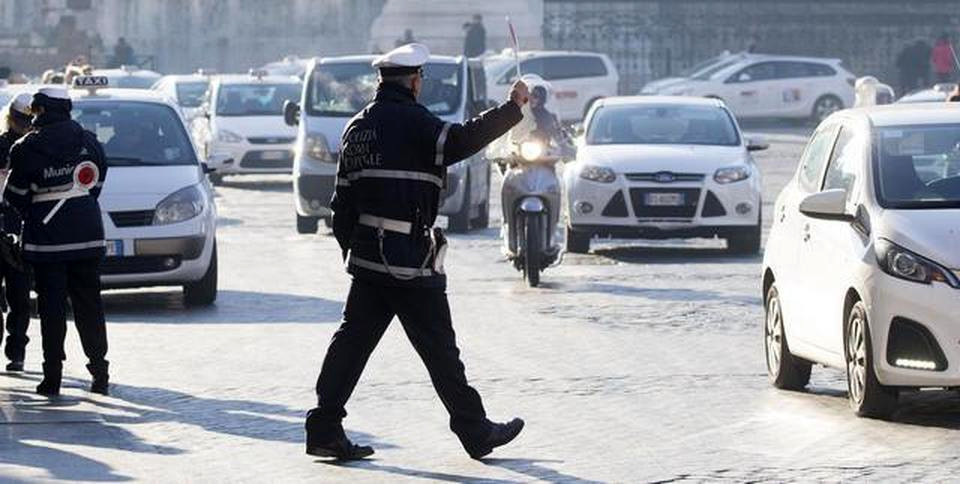 Stay out of big-city centres.
Stay out of big-city centres.
Don’t drive a car for city sightseeing. Park your car and use public transportation or taxis. Be careful; some Europeans, particularly Italians and Greeks, make up their own rules of the road. In Rome, for example, red lights are considered discretionary.
This is what we did in Rome: We found a small town with a good transport link and commuted in. Generally it is as cheap as paying parking fees; the train took us right into the centre of the city without frayed nerves; also, our excellent accommodation was cheaper. It was all sorted on the Internet before we even booked; we emailed what we wanted to do and they said there was no problem; they had local transport on their doorstep. Then the first day we took a €16 hop-on-hop-off tour bus all around Inner Rome to get our bearings and choose what we wanted to do. (You’ll never do everything). If you do stay in the centre of a city, make sure there is some kind of parking arrangement, otherwise it can be a nightmare – or mean a long walk.
Cities across Europe have taken measures to discourage urban driving. For example, to drive anywhere in the centre of London or Stockholm you’ll pay a “congestion charge.” You’ll pay a toll to drive into Oslo and Bergen — but because of their automated systems, you may not know it until you get a bill two months later.
Zona Traffico Limitato. 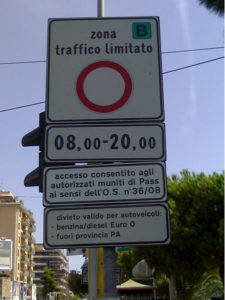 (ZTL, often shown above a red circle) In many Italian city centres vehicle traffic is banned altogether, except for local permit holders. This includes Rome, Naples, Florence, Pisa, Lucca, Siena, San Gimignano, Orvieto, and Verona – and even smaller places. Don’t drive past, or park beyond, these signs. Not one inch! If you do, even briefly and by accident, your license plate will be photographed, usually without your knowledge, and a hefty fine— or fines, if you did it multiple times — will be waiting for you at home. If your hotel is within a restricted area, ask your hotelier to register your car or direct you to legal parking. Also you cannot rely on your SAT-NAV (GPS). I kid you not; we fell foul of this in 2015 in Bergamo. Nine months later the fine dropped through our letter box – and it was well over £100. We hadn’t even seen the sign. (Before you say it, it’s not just for tourists – even the locals fall foul of it.) We had all the hassle and extra expense of obeying their demands for payment via a Bankers’ Order.
(ZTL, often shown above a red circle) In many Italian city centres vehicle traffic is banned altogether, except for local permit holders. This includes Rome, Naples, Florence, Pisa, Lucca, Siena, San Gimignano, Orvieto, and Verona – and even smaller places. Don’t drive past, or park beyond, these signs. Not one inch! If you do, even briefly and by accident, your license plate will be photographed, usually without your knowledge, and a hefty fine— or fines, if you did it multiple times — will be waiting for you at home. If your hotel is within a restricted area, ask your hotelier to register your car or direct you to legal parking. Also you cannot rely on your SAT-NAV (GPS). I kid you not; we fell foul of this in 2015 in Bergamo. Nine months later the fine dropped through our letter box – and it was well over £100. We hadn’t even seen the sign. (Before you say it, it’s not just for tourists – even the locals fall foul of it.) We had all the hassle and extra expense of obeying their demands for payment via a Bankers’ Order.
Since writing this section I have found a blog site that goes into great detail about ZTL’s and in particular those in and around Pisa, Italy. If you go no further than this section in our blog, I urge you to visit this other site if you are going to drive round Italy, because even the small destinations will have these zones. You will come up against them and if you are in a flow of local traffic by mistake, it will be too late. It will be no good stopping in the middle of a crowded road to have a hissy fit. An Italian friend told me this once about Italian red tape, and it is true. Italian bureaucracy is exceedingly slow, but it grinds exceedingly fine. In other word, however long it takes, nothing escapes. Here is the link http://www.athomeintuscany.org/2011/10/15/pisa-ztl-limited-traffic-zone/
Avoid heavy traffic times. The rush hours are generally the same, except the further south you go the closing and opening times change; and the North. Mediterranean resort areas will get extremely congested at the weekends in the height of the summer season. (We always choose to go off-season when the children are still at school. Also, neither of us enjoy extreme heat.)
 To save time, use expressways. The shortest distance between any two European points is the Autobahn/Strada/Route/Cesta. We prefer the more scenic national highway systems (Route Nationale in France) and even smaller roads. These roads are very safe as long as you travel at a sensible speed, but if you have to get from ‘A’ to ’B’ fast then they are not for you, though it really is the only way to see those hidden places and the country properly.
To save time, use expressways. The shortest distance between any two European points is the Autobahn/Strada/Route/Cesta. We prefer the more scenic national highway systems (Route Nationale in France) and even smaller roads. These roads are very safe as long as you travel at a sensible speed, but if you have to get from ‘A’ to ’B’ fast then they are not for you, though it really is the only way to see those hidden places and the country properly.
There are tolls on the main motorway routes in Europe.
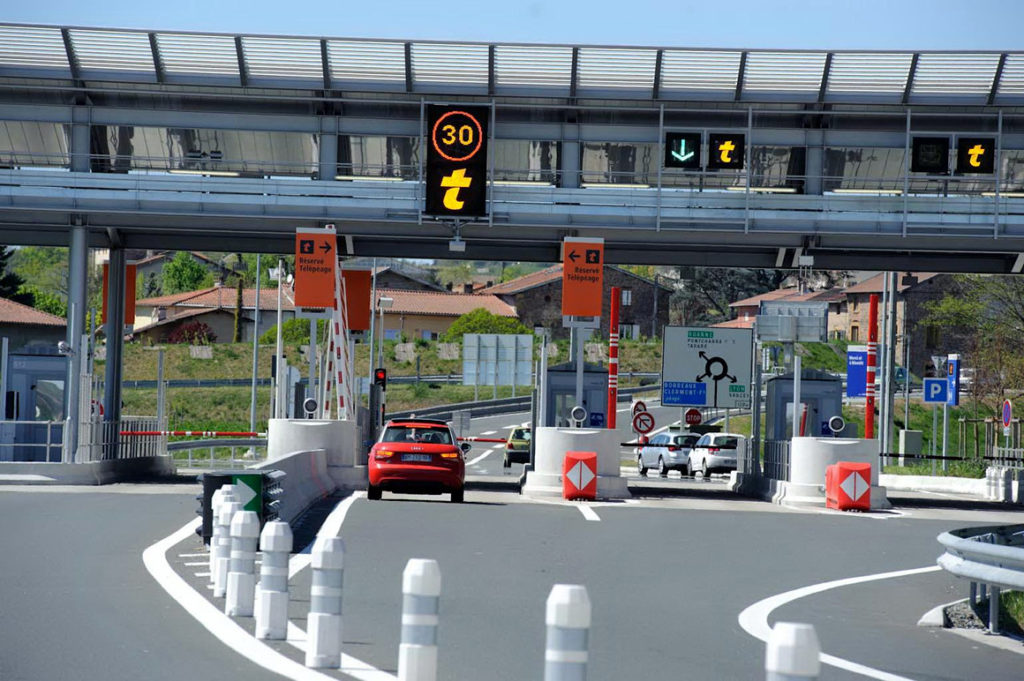 We in Britain are spoilt. Most of our motorways are free, similar to Germany’s famous autobahn. (I believe this is the case for America’s Interstates too.) But on major motorways in much of Mediterranean Europe — including Italy, France, Spain, Portugal, Greece, and Croatia — you’ll periodically encounter toll booths. Fees are based on the distance you drive (about €1 per 10miles in France). I will reiterate what was mentioned in our first post; have a cache of loose change and small notes at hand and remember it will be the passenger who has to pay. As you drive up to the booth, do so slowly and pull in as tight as you can so that they can reach out to pay. My wife is short and so is her reach, so I now stop leaving a gap for the door to open that she can get out and pay. I don’t know if this is illegal as you are actually stepping onto a carriageway, but it’s safe; and we’ve never had a problem.
We in Britain are spoilt. Most of our motorways are free, similar to Germany’s famous autobahn. (I believe this is the case for America’s Interstates too.) But on major motorways in much of Mediterranean Europe — including Italy, France, Spain, Portugal, Greece, and Croatia — you’ll periodically encounter toll booths. Fees are based on the distance you drive (about €1 per 10miles in France). I will reiterate what was mentioned in our first post; have a cache of loose change and small notes at hand and remember it will be the passenger who has to pay. As you drive up to the booth, do so slowly and pull in as tight as you can so that they can reach out to pay. My wife is short and so is her reach, so I now stop leaving a gap for the door to open that she can get out and pay. I don’t know if this is illegal as you are actually stepping onto a carriageway, but it’s safe; and we’ve never had a problem.
Switzerland, and some other countries use a system (called a “vignette”) where you buy a sticker to display on your windscreen. It’ll cost about €35.75 and will last a year. Other countries have short-term vignettes; check out the countries you are visiting. Normally these stickers can be purchased at the border crossings, petrol stations, and post offices. (If you are renting a car you might be lucky and find one on yours that’s not expired.) Don’t think you can get away with not having one. If you don’t display it you’ll be stopped. Fines start around €120.
Traffic cameras are everywhere: In all European countries, automatic cameras monitor and check car speeds, and if you’re heavy on the pedal, a ticket will wing its way by mail to your home. Follow the area speed limit. You may curse some European comrades’ driving habits, but remember you are on their turf. With a little caution, foresight and practice you can enjoy the adrenaline rush. Driving at home may have become a bit boring? Let Europe bring a bit of excitement back into being behind the wheel.

N.B. Jackie sought out and printed the car driving rules (2016) in both France and Italy and deposited them in the black file for me. These were copied and printed from a selection online.
Here are some useful sites:
https://www.gov.uk/government/uploads/system/uploads/attachment_data/file/35559/driving-abroad.pdf
https://www.theaa.com/european-breakdown-cover/driving-in-europe
http://www.theaa.com/driving/index.html
https://www.ricksteves.com/travel-tips/trip-planning
https://about-france.com/driving.htm
BOOKING THE TUNNEL AND FERRIES.
The Euro Tunnel is quite the easiest and quickest way to travel, with many options on offer. Let’s assume you are going for at least three weeks; then the cheapest way is the ‘Single or Long Stay’ but this locks you into a return time and date.
The other way to go is with a Flexiplus, which will be more than twice the price, but it does mean you can turn up anytime within the ticket’s schedule without worrying about missing your slot. https://www.eurotunnel.com/uk/tickets/
Dover to Calais Channel Ferries take about ninety minutes to cross, plus off and on, which alone always seemed longer than the tunnel. It is cheaper than the tunnel, but if you have a rough crossing will you want to do much more travelling that day? http://www.poferries.com/en/dover-calais
Maybe you want to go over night and wake up in France. Brittany Ferries can take you into St Malo and in one days driving from there you are in Burgundy country. That’s after leaving Portsmouth and having a wonderful meal in one of Brittany Ferries’ Onboard Restaurants before going to your cabin and having a night’s kip: Or if you want to rough it, find a lounger and sleep on deck. I’ll leave you to find out the prices. It’s not the cheapest way to go – but we love that experience. http://www.brittany-ferries.co.uk/
INSURANCES.
Car Insurance:
Most insurance companies will cover you when you go abroad. You may have to pay a premium for extra coverage. If you already have a good deal with your Insurers it generally turns out best to stick with them, unless you are about to renew. In that case, shop around. There is nothing like planning ahead to save yourself a few pennies. Make sure all your bases are covered, especially legal costs.
European Accident Statements:
I am putting this as a section on it’s own as not many blogs seem to cover this and it only becomes important if you have an accident and have to fill out a form. The form you will be given will be in the language of the country; in other words if you only have a rudimentary grasp of the language or less, it will be gobbledy-gook. The way around this is to carry a copy or two with you that is translated into English. There are several sites where you can download them as PDF’s. Here is one link; just click on the one that says ‘English’. It’s free; no catch, and it will make life far easier if things get heated when no one understands each other.
Car Breakdown Insurance:
This is a must. You need the full works. There are plenty out there, but don’t be a cheapskate; pay the money and go for reliability. If you are halfway up a mountain in the Dolomites with a crumpled front end, or an engine that’s shot a piston – you’re going nowhere. You need transport back home for your nearest and dearest, the screaming kids, sad car and Moi. Then there’s the luggage – and nights to be arranged to lay your heads down while you get back home. So do the research and look at companies like the AA – Green-flag. I can’t recommend what I haven’t yet used and I hate to tempt providence. Let’s say we’ve been lucky; but we’re always covered.
Car Precheck:
I know, this is a ‘- Duh! Obvious’, but you’ll be surprised at the amount of car owners who think ‘I had my MOT only six months ago and the car’s only three years old so it’ll be alright’. Believe me, there are as many turkeys behind the wheel as on a Christmas dinner plate. I always put the car in for a big checkup with my local mechanic, who I’ve been using for the last 3 years; he is someone I really trust. If he thinks anything is suspect he either changes it or we have a chat and weigh up the odds. Before him I used another guy who’s lad missed checking the rear brakes in 2014.
We were coming down a hill in the middle of Croatia when there was a grinding sound coming from the rear when I applied the brakes. Using the gears, I came to a halt. We sat there silently, wondering what to do. Luckily we were 5 kilometres from our next B&B, so driving very carefully in second gear we crept along until we got there. To our surprise and luck the B&B’s next door neighbour’s son was a mechanic who worked out of his garage. To cut a long story short he sorted it out by finding scrap parts from a junkyard, because it would have taken three days to get new parts from Split. It turned out that the slave cylinder that works the brake was badly corroded and needed changing and that was why the brake shoes wore down. That mechanic said that if my mechanics had taken off the drum to check the brakes, rather than shining a light through the inspection hole at the brake lining, they would have known a failure would be imminent. Believe it or not – I was presented with a bill of €19. I paid his bill gladly and gave him a really good bottle of Italian wine as a thank you.
House Insurance:
It is always wise to check with your Insurers if you are going away for longer than a month, but generally most insurances cover a property to be empty for a certain amount of time. Ours allowed 90 days without it being a problem, but they need to know the name of the temporary key holder, and wanted the water turned off and the tanks drained. That really is no trouble if you have family close by, or good friends or neighbours – we have the latter. When we left we turned off the gas on the heating system as well, and arranged for a good friend who happens to service our boiler to come in a few days before we returned. He serviced the boiler, turned on the gas and water and checked everything. It was early December when we got home and the house was warm as toast.
Travel Insurance:
Maybe I should have started with this, but what can I say? People should take it out and generally it should not cost too much. Just make sure everything is covered; don’t scrimp for a few pennies. Repatriation cover is most important.
IF YOU PLAN TO FLY AND HIRE.
If you plan to fly, most places in Europe will be accessible from your nearest airport. We have also found much cheaper long-stay parking than booking through the airline. All such car parks provide a bus service to your terminal. The best Airport-sited car park we found was Purple Parking, but it was a very long-winded process, unlike the small, private firm we had used before, ten minutes away by their private bus.
We also recommend, if you will be hiring a car, to book a room for the first night a bus ride away from your airport, and hire a car from a local firm recommended by your host. This might not be so easy at the height of the tourist season, so do this in advance. We have done both; the local firms were cheaper than the International Car Hires, and they replaced chewed-up tyres, (and in one case an engine part) swiftly and without charge; whereas the International firms demand you take out extra, expensive insurance, and invariably you will find a bill land on your doormat when you get back – for dents and scratches you can not remember making. If using these firms, we recommend you take photographs of every possible discernible blemish on the entire car before you take hold of the keys. I think most people are aware of the things some hire companies get up to so I will not elaborate on this subject further.
Text by – Graham Usher ‘Graham Liverpool’ on Trip Advisor.)
Photographs by – Graham Usher.
Some of the images came from other sources.
![]()



